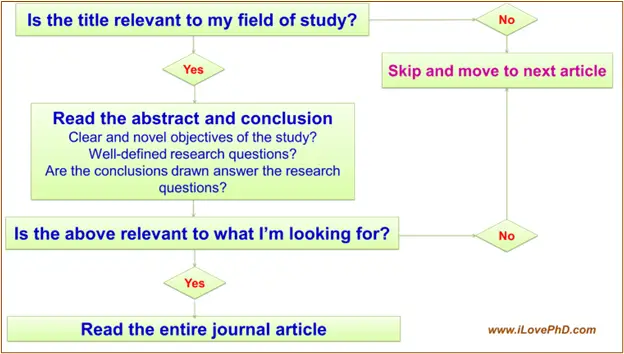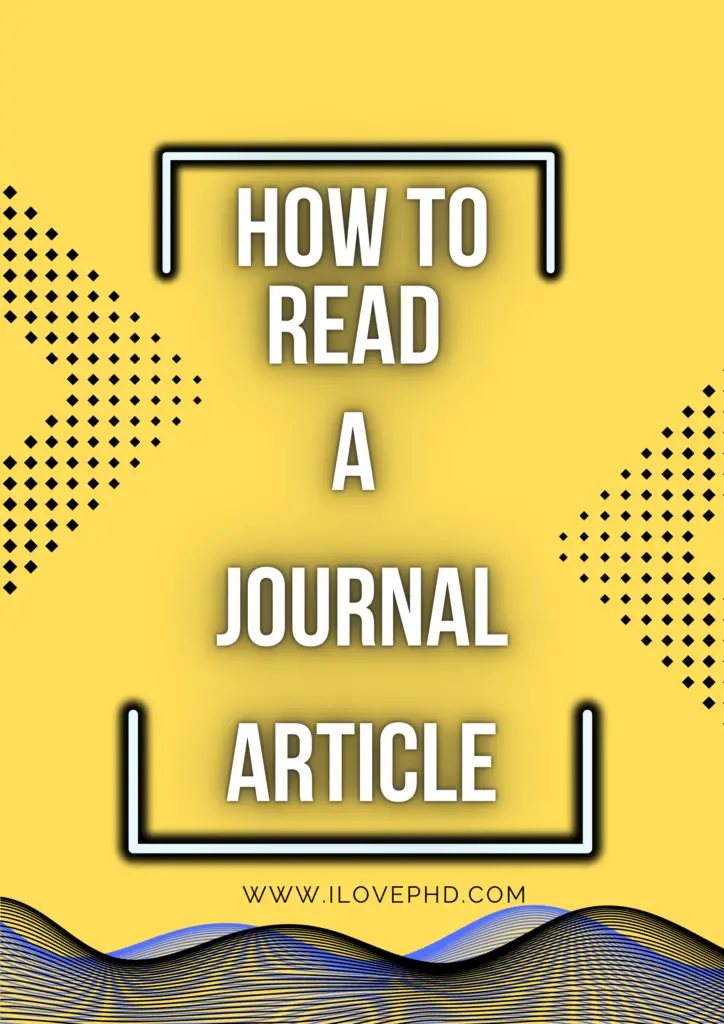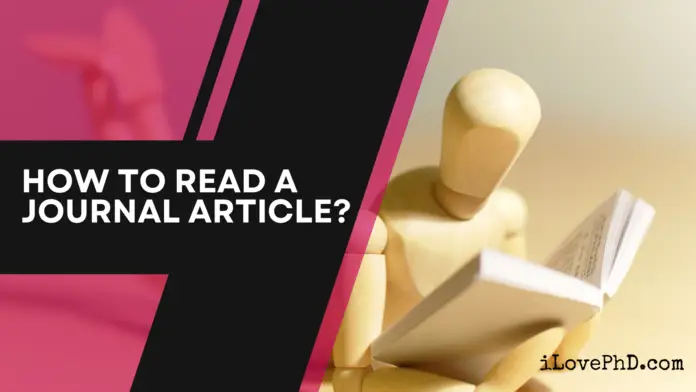Reading scientific journal articles is mandatory for researchers and scientists. With an overflow of numerous journal articles irrespective of the field, it is important to choose and read the correct journal articles. The researcher should develop the ability to attain skills to read research papers with good interest and ease.
The foremost step in reading a journal article is to read the title, abstract, and conclusion. If it is relevant to your research area, then the key elements of the article can be noted. There is no one way to read a journal article, as it depends on the individual and the article itself. However, iLovePhD listed the following tips on how to read a journal article more effectively.
- Start by reading the abstract. This will give you a brief overview of the article and help you decide whether it is relevant to your research.
- Then, read the introduction. This will give you a better understanding of the article’s purpose and scope.
- Skim the article to get an overview of the content before reading it in depth.
- Divide the article down into smaller sections and read each section carefully.
- Read the article in detail, paying attention to the methods, results, and discussion sections.
- Take notes as you read to help you remember key points.
- Ask questions about the article which helps you to understand it better.
- Reflect on the article after reading it to consolidate your understanding.
HOW TO READ A JOURNAL ARTICLE
“There is an art of reading, as well as an art of thinking, and an art of writing”
Clarence Day
The prime rule is: Never start reading an article from the beginning to the end. Identify the conclusions of the research study by reading the title, the abstract, and the conclusion. If you feel it is interesting, novel, and relevant to your field of study, then read the entire article effectively and efficiently. The following flowchart can be used to decide whether to read the chosen article or not.

Flowchart to decide whether to read the selected article or not
Most of the research articles are structured as listed below. However, review articles are written in a different format. Tips to write research paper and review paper is explained extensively at ilovephd.com.
1. The Title
- The title of a manuscript indicates the theme of the research work.
- It will be clear, specific, and attractive to the readers to read the article.
- A perfect title will inspire the reader to decide whether to go ahead with the article or move on to the next one.
- Some titles would be descriptive and self-explanatory and some would be in-general
- For example, the manuscript titled “Wastewater treatment system – A challenge for water technologist” looks very general to a reader while a manuscript entitled “Enhanced performance of an advanced wastewater treatment system for reuse” gives more information for the reader to read the full article.
2. Abstract
- In addition to the title that grabs the reader’s attention, a well-written abstract is important.
- The abstract is what researchers/scientist reads first to identify whether the article is worth reading.
- The novelty of the research work is highlighted. Therefore, a reader should read the abstract twice or thrice for better understanding.
- Some journal articles have graphical abstracts which are easy to understand the work in no time.
- Abstracts are focussed to answer the following questions.
- What was investigated in the study?
- Why was it done?
- How was it done?
- What are the important findings of the study?
- What is the significance and novelty of the study?
- Ensure that the above questions are answered after reading the entire article.
3. Keywords
- The keywords would be relevant to the work and it is easy for the readers to search for the manuscript.
4. Introduction
- Once the reader has decided to read the entire journal article, one can start from the introduction.
- This section of the manuscript addresses the existing knowledge and previous research of the topic.
- It has a clear point regarding the advancement or improvement and a motivation to carry out the research work.
- A good introduction should provide proper background for the study with recent relevant literature.
- This section concludes with the identification of research gaps in the literature and how these gaps motivated the researcher to design a novel work.
- The objectives of the study would be listed at the end of this section.
5. Materials and Methods
- This section elaborated on the technical details of how the research experiments were conducted.
- It includes experimental procedures/steps followed, preparation methods, instrumentation used, and formula.
- The readers would get a clear vision of how the research study was carried out by reading the methods section.
6. Results and Discussion
- This is the most important section of a journal article where the detailed research findings and their interpretations are discussed.
- It emphasizes the experimental result explained scientifically, and logically in line with fundamental science and principles.
- To support the findings, the results would be expressed in the form of plots, figures, graphs, models, tables, expressions, etc.
- The results obtained in the present study would be compared with the results reported in the literature, explaining in what aspects they were different and similar.
- Moreover, this section discusses the strengths and shortcomings of the present study, suggesting the need for further research.
- The reader should meticulously read this section to find out whether the results were original, reliable, and reproducible.
- An important aspect is to check if all the parameters present in the beginning of the study were taken into account at the end of the study.
- The reader should check whether a correct statistical test was conducted for analysis and should check the level of its significance.
- The reader should identify the results that were statistically significant and the results that were not.
- The meaningfulness of the results and their analyses, new hypotheses, limitations of the study, explanation of differences and similarities with previous studies, and suggestions for future research is discussed in detail in this section.
- It is important to remember that the discussions are the authors’ perceptions, elucidations, and opinions rather than facts.
7. Conclusion
- Even though the conclusion section was read at the beginning, it is advisable to read it again to make sure what we had initially presumed was correct and accurate.
- If the conclusion had not made sense earlier, it may make sense after a thorough reading of the entire article.
- Generally, this section includes the summary of the research findings and the overall impression of the study.
- A good conclusion will complete the article’s arguments, research outcome, and further scope of studies.
- The readers may ask questions under various headings of a research paper as a simple questionnaire is shown in the figure below. Writing answers to these questions will help in understanding the critical aspects of the research articles effectively, especially for young researchers.
| Headings | Questions |
|---|---|
| Title | 1. Is the title relevant to my field of study? |
| Abstract | 2. What was investigated in the study? 3. Why was it done? 4. How was it done? 5. What were the important findings of the study? |
| Introduction | 6. What was the significance and novelty of the study? 7. What was the need for the research study? 8. Was the research gap identified? 9. What were the research questions? 10. Was the present study compared with the previous relevant literature? 11. What were the objectives of the study? |
| Materials and Methods | 12. How the researcher designed the experiments? 13. How the experimental setup was done? 14. How was the sampling done? 15. How was the experiment done? 16. What was the experimental procedure? 17. What were the parameters considered (Variables and constants)? 18. What parameters were measured? 19. What were the models considered? 20. What instrument/technique/method was used for data collection and analysis? 21. What statistical tests were used for evaluation? 22. What empirical formulae were used for calculation? |
| Results and Discussion | 23. What were the major findings of the research study? 24. Were all the parameters considered at the beginning of the study discussed in this section? 25. Where the results are original, reliable, and reproducible? 26. Were the plots, figures, and tables easy to understand? 27. Did the research findings answer all the research questions? 28. Were the results interpreted scientifically and logically in line with the fundamental science? 29. How were the results different /similar from other studies? 30. What were the strengths and limitations of the study? 31. Did the results obey the established theory and principle? |
| Conclusion | 32. What was the take-home message of the journal article? 33. Was the conclusion reasonable and logical? 34. Where the results are summarized? 35. Was the article worth reading? 36. Is the research has the scope for further study? |
A simple questionnaire for researchers to read a journal article
8. References
- Citing references in appropriate places in the article is necessary and important to avoid plagiarism.
- The references would be listed at the end of the manuscript and each journal has its own referencing style.
TAKE HOME THE MESSAGE OF THE ARTICLE
“Let us read with method, and propose to ourselves an end to which our studies may point. The use of reading is to aid us in thinking.”
Edward Gibbon
Reading scientific journal articles has become obligatory to have deep knowledge and a better understanding of the current state-of-art technologies and inventions. As numerous articles are getting published, it is important to choose the right articles and develop a systematic method for reading these manuscripts. An effective, efficient, and logical approach has been presented to the researchers for choosing and reading the right articles for a better understanding
References
Subramanyam R. (2013), Art of reading a journal article: Methodically and effectively. J Oral Maxillofac Pathol. 17(1): 65-70.



